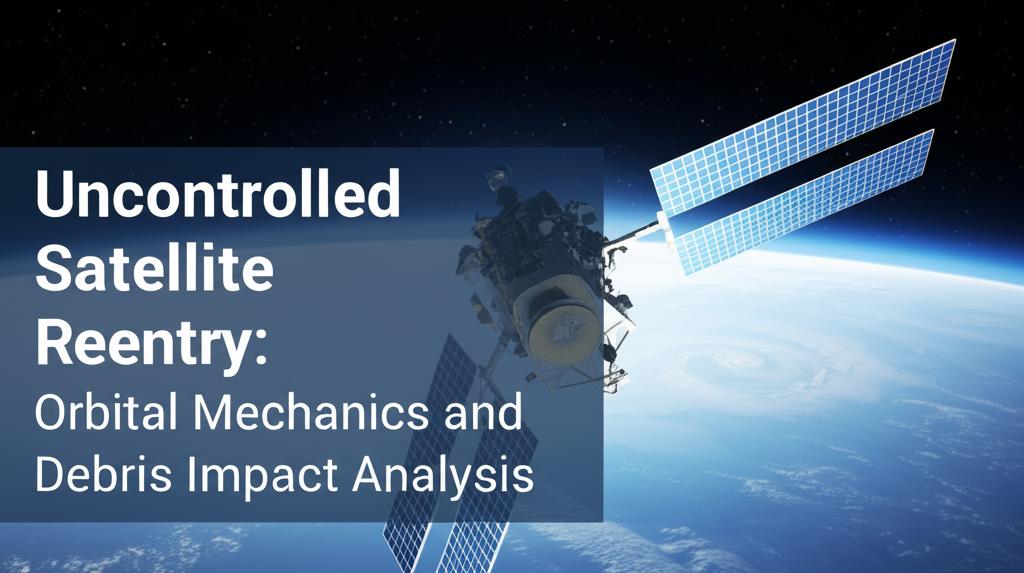Uncontrolled satellite reentries occur when a space object, such as a defunct satellite or a spent rocket stage, falls back to Earth without any human guidance or ability to steer its descent. This process is primarily governed by the principles of orbital mechanics and the interaction of the object with the Earth's atmosphere.
Orbital Mechanics of ReentrySatellites in Low Earth Orbit (LEO), typically below 2,000 kilometers, are subject to atmospheric drag. Although the atmosphere at these altitudes is extremely thin, the continuous friction it creates gradually reduces a satellite's orbital velocity. As the satellite slows down, its orbital altitude decreases. This process of orbital decay is not uniform; it is influenced by factors such as the satellite's size, shape, mass, and the density of the atmosphere, which itself varies with solar activity. Increased solar activity heats and expands the upper atmosphere, leading to greater drag on satellites.
Initially, a satellite's orbit might be elliptical, with a perigee (closest point to Earth) and an apogee (farthest point). Atmospheric drag primarily affects the satellite at its perigee, where the air is densest. This drag reduces the apogee height more significantly than the perigee height, causing the orbit to become more circular over time, and then to spiral inwards. Once the altitude drops to around 120 kilometers, the atmospheric drag becomes so intense that the object can no longer maintain its orbit, and the final, rapid descent begins. The exact point of reentry is difficult to predict with high accuracy far in advance due to the complexities in modeling atmospheric density and the satellite's aerodynamic properties.
Reentry Breakup and Debris GenerationAs a satellite reenters the denser parts of the atmosphere, typically between 80 and 120 kilometers altitude, it experiences intense heat due to air compression and friction. Temperatures can reach thousands of degrees Celsius, causing the satellite to heat up, melt, and fragment. Most of the satellite's mass, particularly components made of aluminum or other materials with lower melting points, will burn up and vaporize.
However, certain components made of high-melting-point materials, such as titanium alloys, stainless steel, or ceramic composites (often found in fuel tanks, engine parts, or optical instruments), can survive the extreme conditions of reentry. These surviving fragments continue their descent, potentially reaching the Earth's surface. The size, number, and dispersion of these debris pieces depend on the satellite's original construction, its orientation during breakup, and atmospheric conditions.
Debris Impact Analysis and Risk AssessmentPredicting where surviving debris will land is a significant challenge. Space surveillance networks around the world, such as the U.S. Space Surveillance Network, track objects in orbit and provide reentry predictions. These predictions typically involve a reentry window – a period during which the reentry is expected to occur – and a ground track indicating the possible areas over which the satellite might reenter. However, even hours before reentry, the uncertainty in the impact footprint can span thousands of kilometers. This is because a small uncertainty in the time of reentry translates to a large downrange distance due to the high orbital velocity (around 7.8 km/s in LEO).
Risk assessment focuses on the probability of human casualty from surviving debris. This calculation considers the predicted debris footprint, the population density within that footprint, and the estimated amount and size of surviving debris. While the overall statistical risk to any single individual is extremely low (as most of the Earth's surface is water or sparsely populated land), the potential for damage or injury, however small, is taken seriously, especially for large objects. International guidelines encourage designing satellites for controlled reentry (e.g., by including dedicated propulsion systems to steer them to safe, unpopulated areas like the South Pacific Ocean Uninhabited Area) or for "design for demise," where satellites are built to burn up more completely upon reentry.
The growing number of satellites being launched, particularly in large constellations, increases the future likelihood of uncontrolled reentries if end-of-life disposal measures are not effectively implemented. Ongoing research focuses on improving atmospheric models, better tracking capabilities, and international cooperation to mitigate the risks associated with uncontrolled satellite reentries.

